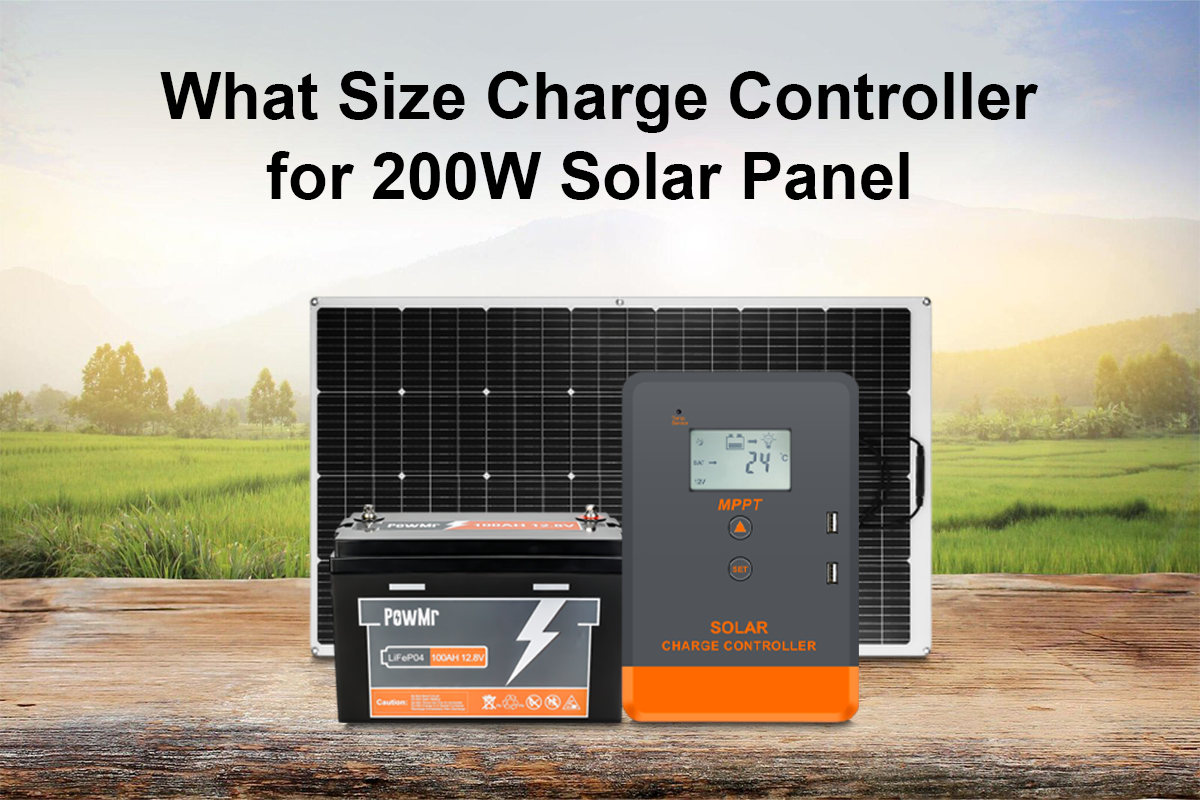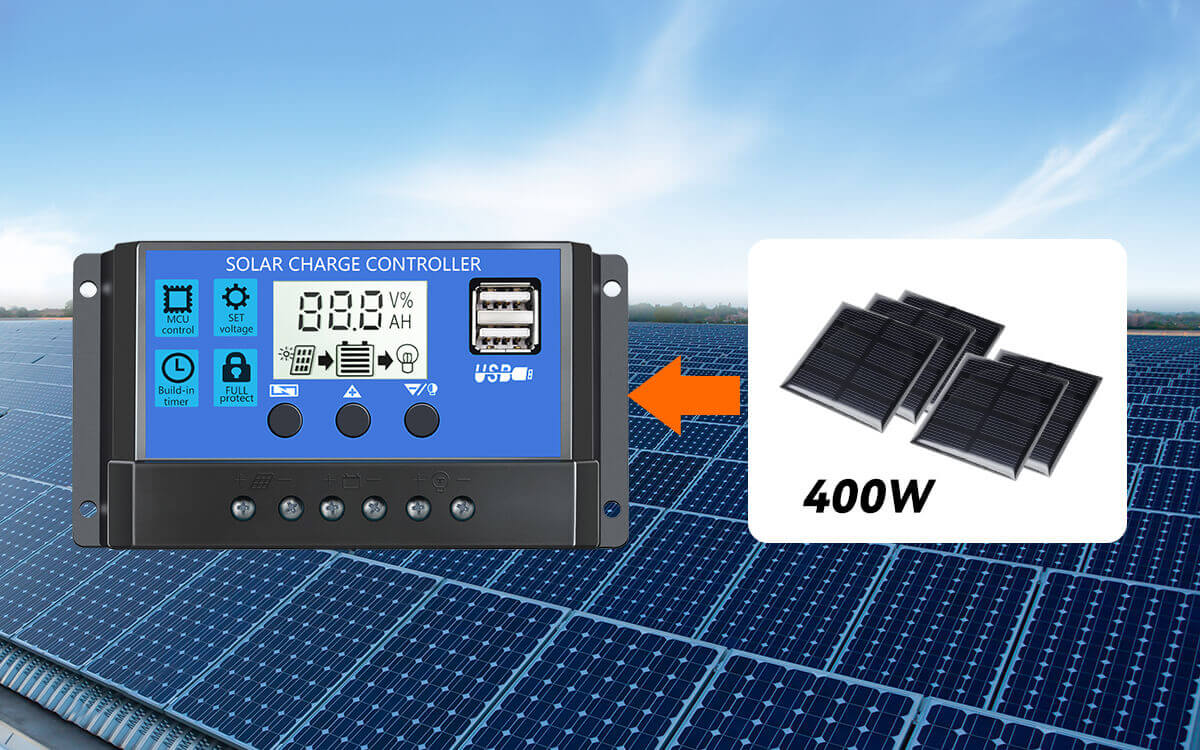เมื่อการติดตั้งระบบพลังงานแสงอาทิตย์ การเลือกส่วนประกอบที่เหมาะสมเป็นสิ่งสำคัญสำหรับประสิทธิภาพและอายุการใช้งานที่ดีที่สุด ส่วนประกอบที่สำคัญอย่างหนึ่งคือ ตัวควบคุมการชาร์จพลังงานแสงอาทิตย์ ซึ่งควบคุมการไหลของพลังงานจากแผงโซลาร์เซลล์ไปยังแบตเตอรี่ การเข้าใจวิธีการเลือกขนาดตัวควบคุมการชาร์จให้เหมาะสมกับการตั้งค่าของคุณเป็นสิ่งสำคัญสำหรับประสิทธิภาพและความปลอดภัย
โดยทั่วไป, ตัวควบคุมการชาร์จพลังงานแสงอาทิตย์ 20A เหมาะสำหรับระบบแผงโซลาร์เซลล์ขนาด 200 วัตต์ ในบทความนี้ เราจะอธิบายว่าทำไมขนาดนี้จึงเหมาะสมและประเภทของตัวควบคุมการชาร์จที่เหมาะสมที่สุดสำหรับการตั้งค่าพลังงานแสงอาทิตย์ 200W คืออะไร
การเลือก ตัวควบคุมการชาร์จโซลาร์เซลล์ MPPT ที่เหมาะสมสำหรับ แผงโซลาร์เซลล์ 200W จำเป็นต้องพิจารณาปัจจัยต่าง ๆ อย่างละเอียดเพื่อให้มั่นใจในประสิทธิภาพและความเข้ากันได้ นี่คือ คำถามสำคัญ ที่ควรตอบก่อนตัดสินใจซื้อ:
ปัจจัยที่ 1 - กำลังไฟฟ้าสูงสุดของแผงโซลาร์เซลล์คือเท่าไร
กำลังไฟฟ้าสูงสุด ของแผงโซลาร์เซลล์ ซึ่งมักเรียกว่า Pmax หมายถึงกำลังไฟฟ้าสูงสุดที่แผงสามารถผลิตได้ภายใต้สภาวะที่เหมาะสม (STC) ตัวชี้วัดนี้มีความสำคัญเพื่อให้แน่ใจว่าตัวควบคุมการชาร์จโซลาร์เซลล์เข้ากันได้
ค้นหาค่าพิกัด Pmax ได้ที่ป้ายที่ติดอยู่ที่ ด้านหลัง ของแผงหรือใน แผ่นข้อมูล ของแผง จำเป็นอย่างยิ่งที่จะต้องตรวจสอบว่ากำลังไฟฟ้ารวมของแผงโซลาร์เซลล์ ไม่เกิน กำลังไฟฟ้าสูงสุดของอินพุต PV ที่ตัวควบคุมที่เลือกสามารถรองรับได้
ปัจจัยที่ 2 - แรงดันไฟฟ้าของแบตเตอรี่แบงค์คือเท่าไร
ขนาดของตัวควบคุมการชาร์จถูกกำหนดโดยการหารกำลังวัตต์ของแผงโซลาร์เซลล์ด้วยแรงดันไฟฟ้าของแบตเตอรี่เพื่อคำนวณกระแสไฟฟ้า (แอมป์) ตัวอย่างเช่น แผง 200W ที่ชาร์จแบตเตอรี่ 12V จะดึงกระแสประมาณ 16.7A ซึ่งเป็นเหตุผลที่ตัวควบคุมการชาร์จ 20A เพียงพอสำหรับแผงโซลาร์เซลล์ 200W
สิ่งสำคัญคือต้องเข้าใจว่าแรงดันไฟฟ้าของแบตเตอรี่แบงค์ขึ้นอยู่กับวิธีการเชื่อมต่อแบตเตอรี่ ในการเชื่อมต่อแบบอนุกรม แรงดันไฟฟ้าของแบตเตอรี่จะถูกบวกเข้าด้วยกัน ในขณะที่ในการเชื่อมต่อแบบขนาน แรงดันไฟฟ้าจะคงที่แต่ความจุ (แอมป์-ชั่วโมง) จะเพิ่มขึ้น การตั้งค่านี้มีผลโดยตรงต่อกระแสไฟฟ้าที่ตัวควบคุมการชาร์จต้องจัดการ
บทความที่เกี่ยวข้อง:การต่อแบตเตอรี่แบบอนุกรมกับแบบขนานในระบบพลังงานแสงอาทิตย์
ไม่ว่าระบบของคุณจะใช้แบตเตอรี่ 12V, 24V หรือ 48V คุณสามารถกำหนดขนาดตัวควบคุมการชาร์จที่ต้องการโดยใช้สูตรนี้:
กระแสของตัวควบคุมการชาร์จ (A) = กำลังไฟรวมของแผงโซลาร์เซลล์ (W) ÷ แรงดันแบตเตอรี่ (V)
PWM หรือ MPPT: ตัวควบคุมการชาร์จแบบใดเหมาะกับแผงโซลาร์เซลล์ 200W?
เมื่อพูดถึงการเลือกคอนโทรลเลอร์ชาร์จระหว่าง PWM หรือ MPPT สำหรับระบบแผงโซลาร์เซลล์ 200W ความแตกต่างในประสิทธิภาพ ไม่สำคัญมาก หากคุณตรวจสอบสเปคของแผง 200W ทั่วไป คุณจะเห็นว่ามันมักจะต่ำกว่า 24V — มักจะทำงานใกล้เคียง 18V ภายใต้เงื่อนไขการทดสอบมาตรฐาน — ซึ่งใกล้เคียงกับแรงดันชาร์จของแบตเตอรี่ 12V
ภายใต้เงื่อนไขเหล่านี้ ประสิทธิภาพที่เหนือกว่าของ คอนโทรลเลอร์ MPPT เมื่อเทียบกับ PWM มีน้อยมาก ดังนั้น คอนโทรลเลอร์ PWM จึงเป็นตัวเลือกที่คุ้มค่าและใช้งานได้จริงสำหรับการตั้งค่านี้ อย่างไรก็ตาม หากคุณวางแผนที่จะขยายระบบในอนาคต การลงทุนในคอนโทรลเลอร์ MPPT อาจเป็นทางเลือกที่ดีกว่าในระยะยาว
บทความที่เกี่ยวข้อง: บทบาทของตัวควบคุมการชาร์จพลังงานแสงอาทิตย์ & มันทำงานอย่างไร
ในกรณีใดก็ตาม คุณสามารถเลือกคอนโทรลเลอร์ที่มีกระแสไฟฟ้าสูงกว่า เช่น 25A, 35A หรือแม้แต่ 40A ตราบใดที่กระแสไฟฟ้าขาออกยังคงอยู่ภายในขีดจำกัดกระแสชาร์จสูงสุดของแบตเตอรี่ของคุณ
ข้อควรพิจารณาอื่น ๆ เมื่อเลือกตัวควบคุมการชาร์จโซลาร์เซลล์
แผงโซลาร์เซลล์ 200W ผลิตกระแสกี่แอมป์
เมื่อเลือกตัวควบคุมการชาร์จ นอกจากการพิจารณาแรงดันไฟฟ้าวงจรเปิดแล้ว พารามิเตอร์สำคัญอีกอย่างของแผงโซลาร์เซลล์ที่ต้องพิจารณาคือ Isc หรือ กระแสลัดวงจร ของแผงโซลาร์เซลล์ Isc แสดงถึงกระแสที่ไหลออกจากแผงเมื่อขั้วบวกและลบถูกลัดวงจรภายใต้เงื่อนไขการทดสอบมาตรฐาน ซึ่งบ่งชี้ถึง กระแสสูงสุดที่แผงสามารถจ่ายได้ โดยไม่เกิดความเสียหาย
ช่วงแรงดันไฟฟ้าที่ทำงานของตัวควบคุมการชาร์จคืออะไร?
นอกจากนี้ เพื่อประสิทธิภาพสูงสุดและกำลังไฟสูงสุดจากแผงโซลาร์เซลล์ จำเป็นต้องพิจารณาแรงดันไฟฟ้ากำลังสูงสุด (Vmp) ของแผงโซลาร์เซลล์
ช่วงแรงดันไฟฟ้าที่ใช้งานของตัวควบคุมการชาร์จโซลาร์เซลล์ควร ครอบคลุม Vmp ของแผงโซลาร์เซลล์เพื่อรับประกันการแปลงพลังงานอย่างมีประสิทธิภาพในสภาพแสงและโหลดที่แตกต่างกัน
แผงโซลาร์เซลล์เชื่อมต่อแบบอนุกรมหรือไม่?
เมื่อแผงโซลาร์เซลล์เชื่อมต่อแบบอนุกรม แรงดันไฟฟ้าจะถูกบวกกัน ดังนั้นจึงจำเป็นต้องพิจารณา Voc รวมของชุดแผงโซลาร์เซลล์ ซึ่งแสดงถึงแรงดันไฟฟ้าสูงสุดที่ออกโดยไม่มีโหลด โดยปกติจะวัดภายใต้เงื่อนไขการทดสอบมาตรฐาน (STC)
เพื่อให้การทำงานปลอดภัยและเชื่อถือได้ การจัดอันดับแรงดันไฟฟ้าขาเข้าสูงสุดของตัวควบคุมการชาร์จ ต้องไม่ต่ำกว่า Voc รวมของแผงโซลาร์เซลล์ที่เชื่อมต่อแบบอนุกรม
ระบบโซลาร์เซลล์ของคุณเผชิญกับอุณหภูมิสุดขั้วหรือไม่?
อุณหภูมิส่งผลต่อแรงดันไฟฟ้าของแผงโซลาร์เซลล์และประสิทธิภาพการชาร์จแบตเตอรี่ อุณหภูมิสูงจะลดแรงดันและกำลังของแผง ในขณะที่อุณหภูมิต่ำอาจทำให้แรงดันสูงเกินขีดจำกัดของตัวควบคุม ประสิทธิภาพการชาร์จแบตเตอรี่ก็เปลี่ยนแปลงไปด้วย เสี่ยงต่อการชาร์จเกินหรือชาร์จไม่เต็ม ตัวควบคุมที่มี การชดเชยอุณหภูมิ หรือรองรับเซ็นเซอร์ภายนอกช่วยรักษาความปลอดภัยและประสิทธิภาพ โดยเฉพาะในสภาพอากาศสุดขั้ว



